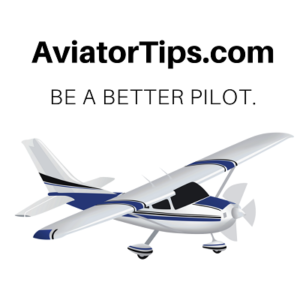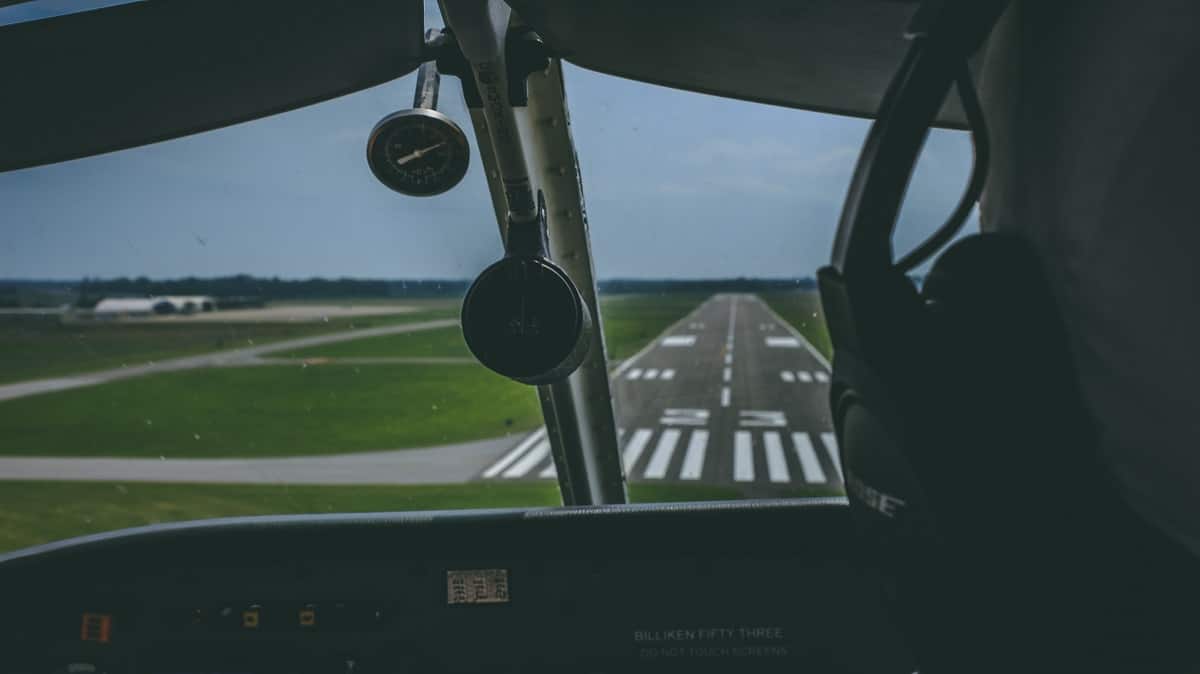One of the challenging parts of learning to fly is understanding airport traffic patterns. Just like when you drive your car, airports have rules and procedures that need to be followed in order to maintain the safe flow of air traffic. This is especially important at uncontrolled airports where there’s no control tower to keep everything organized. Following is a discussion of how to enter and exit the traffic pattern at an uncontrolled airport.
Standard Traffic Pattern Direction – Entries and Exits
The FAA has defined standard methods for entering and exiting the traffic pattern at airports. These are the preferred methods in order to keep traffic flowing in an organized and safe manner. The standard entry and exit methods are:
Standard Traffic Pattern Entry
A standard traffic pattern entry is made by entering the downwind leg at midfield, on a 45-degree angle, and at the correct pattern altitude. This allows the pilot to see, and be seen by, other air traffic.
Standard Traffic Pattern Exit
A standard traffic pattern exit is made in one of two ways. First, by flying straight out on the runway heading for at least 2 nautical miles (nm). Or second, by making a 45-degree turn in the direction of the traffic pattern once reaching 500ft above ground level (AGL).
If coming from the downwind side of the airport, the pilot makes a standard traffic pattern entry by flying directly into the pattern at a 45-degree angle.
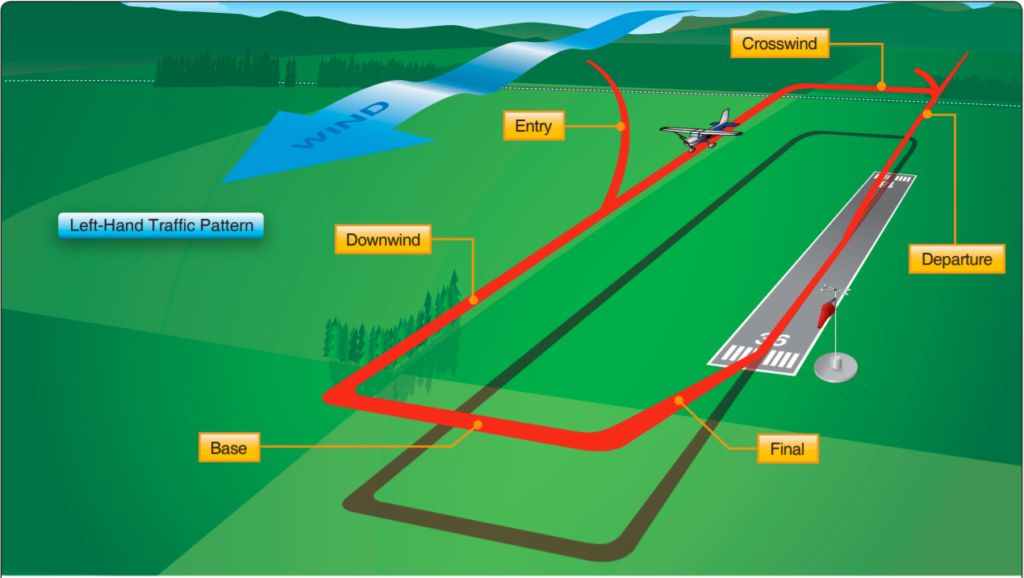
However, if the pilot is approaching from the opposite side, there are two options.
The first and preferred method is to overfly the field at a minimum of 500 feet above the highest pattern altitude and fly clear of the traffic pattern. Then, the pilot will descend to pattern altitude and make a standard entry. (See method A in the image below.)
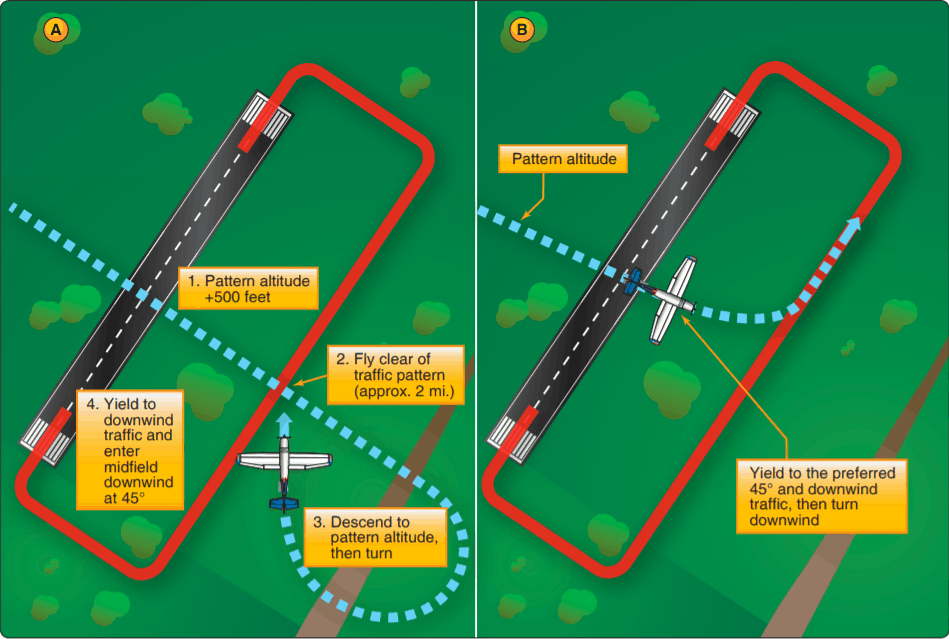
The alternate method is to enter the downwind directly opposite the standard 45-degree entry. This requires the pilot to carefully watch for and yield to downwind traffic. (See method B.)
Now, let’s discuss traffic patterns in a bit more detail.
What Is The Standard Traffic Pattern?
A Standard Traffic Pattern is a rectangular path that flows counter-clockwise with the active airport runway as the “departure” leg. Aircraft will make left turns to follow the pattern and will maintain a standard altitude of 1,000 feet AGL.
For higher performance airplanes such as multi-engine, turbo-prop, and/or jet aircraft, the standard pattern altitude is 1,500 feet AGL. Any traffic pattern other than a left pattern with these prescribed altitudes is a non-standard pattern.
The image below shows what a right-hand airport traffic pattern looks like.
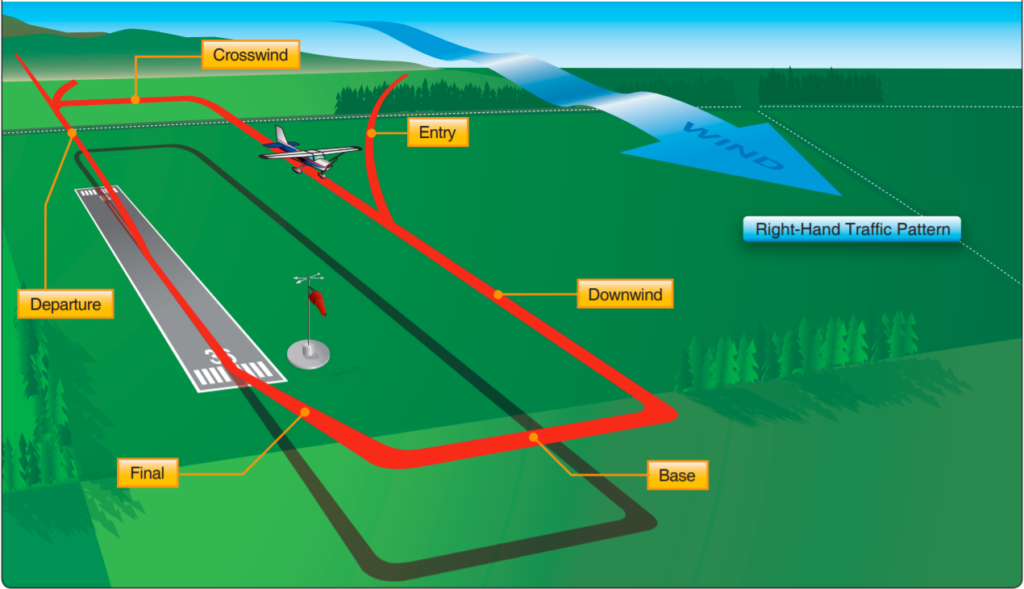
Components of a Traffic Pattern
A traffic pattern is made up the departure leg, the crosswind leg, the downwind leg, the base leg, the final approach leg, and the upwind leg. The departure leg and upwind leg are sometimes considered to be one and the same. However, since they are technically different, we’ll discuss them separately.
The Departure Leg
The departure leg is the segment that follows the centerline of the active runway. It extends from the threshold beyond the departure end of the runway and connects to the crosswind leg. Pilots take off in the direction that’s closest to heading directly into the wind.
The Crosswind Leg
The crosswind leg runs perpendicular to and connects the departure and downwind legs.
The Downwind Leg
The downwind leg runs parallel to and in the opposite direction of the departure leg. This leg connects the crosswind and base legs. The downwind leg is typically 1/2 to 1 mile away from the active runway. This is close enough that the airplane can glide to the runway to make a safe landing in the event of an engine failure.
The Base Leg
The base leg runs perpendicular to and connects the downwind and final approach legs.
The Final Approach
The final approach is the short segment that connects the base leg to the threshold of the active runway, where the departure leg begins.
The Upwind Leg
While not shown on the image above, the upwind leg runs parallel to the downwind leg but on the opposite side of the runway. This leg is usually followed by a turn to join the crosswind. Generally, it’s used after a go-around to side-step and stay clear of the active runway.
Read also: Why Do Pilots Do A Go Around?
How To Determine Traffic Pattern Direction
Prior to entering the pattern, a pilot needs to first confirm the traffic pattern direction. This is accomplished using a number of readily available methods.
Airport Traffic Pattern Indicators
A pilot can determine the traffic pattern direction by using the FAA’s Airport/Facility Directory (AFD). In the image below, you can see where a right-hand traffic pattern is indicated by the “Rgt tfc.” notation for runways 08R, 03, and 08L.
The Traffic Pattern Altitude (TPA) is also noted in the airport remarks section.
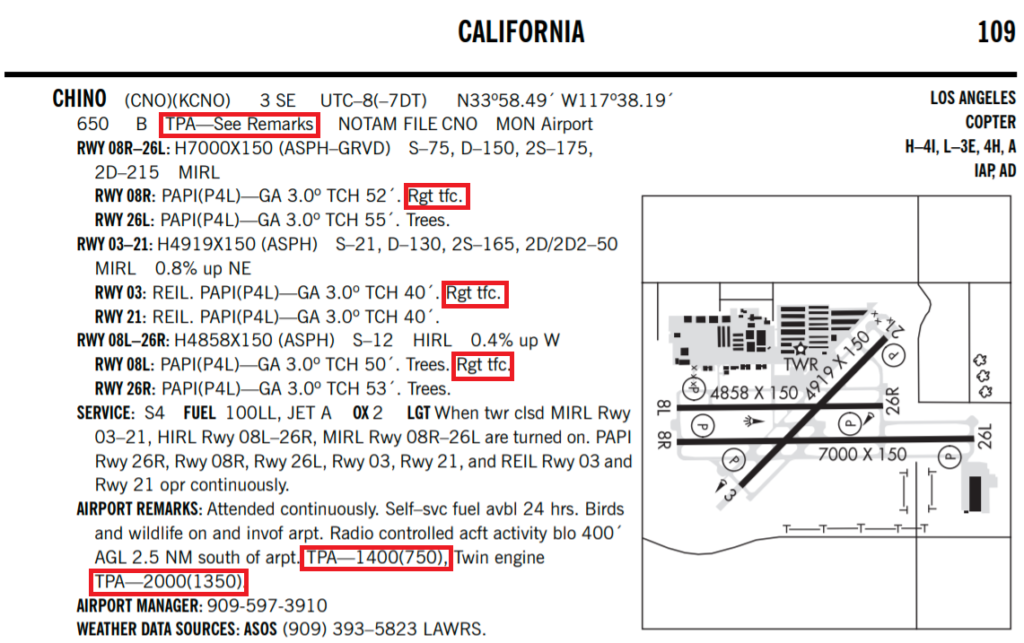
A pilot can also determine the pattern direction by the pattern indicators on the airport’s segmented circle. A segmented circle is a visual indicator on the grounds of an airport that provides traffic pattern information to pilots. The traffic pattern indicators, as shown in the image below, point in the direction of the pattern for each runway.
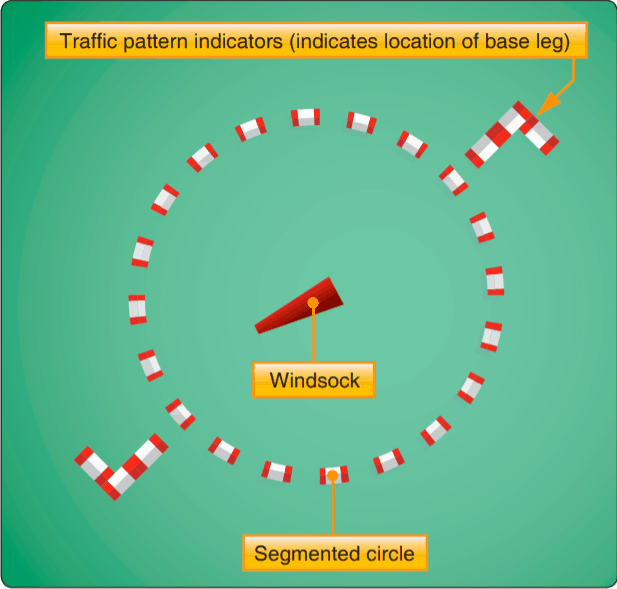
Airport Traffic Pattern Altitude
It’s important to remember that while patterns may reference AGL altitudes, they are always flown using Mean Sea Level (MSL) altitudes. This is because altimeters display MSL, not AGL.
If the field elevation is 700 feet at a given airport, and the airport uses a standard traffic pattern altitude of 1,000 feet, pilots will fly a TPA of 1,700 feet.
Radio Communication: CTAF Procedures at an Uncontrolled Airport
When you enter or exit the traffic pattern at an uncontrolled airport, radio communication is critical. Since there’s no tower to control traffic, pilots should broadcast their intentions on the Common Traffic Advisory Frequency (CTAF). This is a radio frequency assigned to the specific airport that used for exactly this purpose.
Only one pilot can speak on the frequency at a time. As a result, it’s important to communicate clearly and briefly. The FAA recommends five radio calls for an aircraft coming into land. These calls are:
- 10 miles out
- Entering the pattern on the downwind leg
- Turning onto the base leg
- On final approach
- After leaving the runway
Again, communications should be clear. In addition to being brief, they should identify the airport, who you are, where you are, and what you’re doing.
Hometown traffic, Cessna 1234 Alpha, 10 miles west at 3,000, inbound for full stop, Hometown traffic.
There need only be two radio calls for departing flights.
- Before taxiing to the runway
- After taxiing onto the runway for departure
Hometown traffic, Cessna 1234 Alpha, departing runway three four, departure to the east, Hometown traffic.
While radio communications are extremely important at uncontrolled airports, it’s also important to remember that not all aircraft have radios. Vintage aircraft often don’t have electrical systems and aren’t required to have radios if they operate in uncontrolled airspace. For this reason, pilots always need to be watching for other aircraft.
Read also: How Do Planes Communicate With Air Traffic Control?
How Do You Fly a Traffic Pattern?
Flying a traffic pattern is a fairly simple process. With that said, the specific configuration of the aircraft varies widely by type. For example, airspeed, flap settings, and other aircraft requirements are different for each type of airplane. For this reason, the process below is only a generalization of the proper steps.
Prior to entering the traffic pattern, a pilot must be familiar with the specific airport’s runway layout, pattern altitude, and radio frequencies.
Active Runway
The pilot can confirm the published traffic pattern by looking at the AFD, a sectional chart, or the airport’s segmented circle. However, for uncontrolled airports, it’s important to confirm what runway is actually in use. This should be done by visually watching aircraft in the pattern and by listening to the CTAF.
Wind Direction
Generally speaking, the active runway should be the one with the most direct headwind. Wind direction can be determined by listening to the airport’s Automatic Terminal Information Service (ATIS) or Automated Weather Observation System (AWOS) broadcast.
In addition to the airport’s weather broadcast, a pilot can identify the wind direction by looking at the windsock, wind tee, or tetrahedron on the airfield. These are usually placed near the runway but the location will be listed on the airport’s AFD page.
Flying The Traffic Pattern
Pilots should maintain a safe distance from the airport before actually entering the pattern. A good rule is to keep a minimum of 2nm away until the pattern and active runway are confirmed.
In addition, pilots should make all turns in the pattern at a bank angle of 30 degrees. This will allow the pilot to accurately judge the effect of the wind on the aircraft.
1) Pattern Entry
Enter the traffic pattern in level flight, abeam the midpoint of the runway, at pattern altitude. As noted before, the entry should be made to the downwind leg at a 45-degree angle to provide the most visibility of other aircraft.
2) Downwind and Base Legs
Maintain pattern altitude until the airplane is abeam (across from) the touchdown point of the approach end of the active runway. Then, decrease power, add flaps as necessary, and start the descent.
When a minimum of 1/4 mile beyond the approach end of the runway, turn 90 degrees to the base leg. Typically, the base turn is started when the touchdown point on the runway is at a 45-degree angle behind the pilot’s left shoulder. Reduce power and add flaps as necessary. You may also need to correct for wind in order to maintain the proper ground track.
3) Final Approach
When you turn onto the final approach leg, make sure that the aircraft is lined up on the centerline of the runway. Adjust the pitch and power as necessary to maintain a stable approach. If the aircraft becomes unstable prior to landing and you’re unable to immediately correct it, go around.
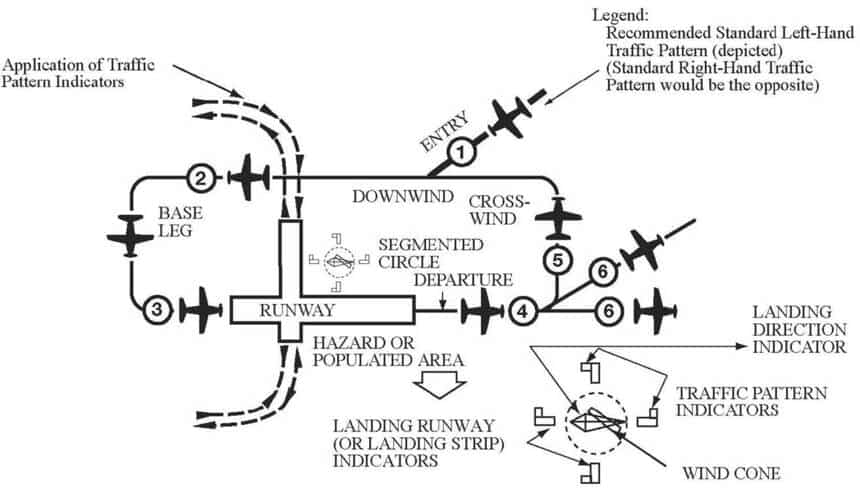
4) Departure Leg
When taking off, performing a “touch and go”, or going around, continue straight ahead along the runway centerline until you’re beyond the departure end of the runway. (If going around to avoid traffic, it’s also appropriate to “side-step” the runway and fly the upwind leg.)
5) Crosswind Leg
If remaining in the traffic pattern, turn to the crosswind leg beyond the departure end of the runway, once the aircraft has reached a minimum of 500 feet AGL. Just as on the base leg, you may need to correct for wind in order to maintain the proper ground track.
6) Pattern Departure
If departing the traffic pattern, continue straight out to a distance of at least 2nm from the airport. Or, once you’re beyond the departure end of the runway, exit with a 45-degree turn in the direction of the traffic pattern after reaching pattern altitude.
Private Pilot Practical Test Standards
On a bit of a side note, understanding how to properly fly a traffic pattern is an important part of learning to fly. There are a number of key skills that student pilots should be able to perform when they take their check-ride, such as the following:
1) Comply with proper traffic pattern procedures
2) Maintain proper spacing from other aircraft
3) Correct for wind drift to maintain proper ground track
4) Maintain orientation with the active runway
5) Maintain traffic pattern altitude within 100 feet
6) Maintain airspeed within 10 knots (indicated)
Controlled Airport Traffic Pattern Procedures
Traffic patterns are the same whether it’s at a controlled or uncontrolled airport. However, the difference with a controlled airport is that Air Traffic Control (ATC) will control the air traffic. ATC is responsible for aircraft separation and will give instructions to aircraft in order to make sure they approach or depart safely.
ATC may direct pilots to perform other maneuvers in order to maintain separation from other aircraft. These maneuvers can include s-turns or 360s. Pilots should be prepared to follow these instructions and should also ask for clarification if they are unsure what the controller is asking them to do.
In addition, it’s important to remember that the Pilot In Command (PIC) is always responsible to “see and avoid” other aircraft, regardless of whether or not they are in controlled airspace. For this reason, pilots should always be watching for other air traffic, even when receiving instructions from a controller.
Summary
Understanding how to enter and exit the traffic pattern at an uncontrolled airport is important for pilots of every skill level. Utilizing standard procedures and communication practices are vital to aviation safety.
Read also: Is It Legal To Land A Plane On A Road?
Recent Posts
FAA MOSAIC Final Rule: What Pilots, Manufacturers, and the Aviation Community Need to Know
Learn how the FAA’s MOSAIC final rule revolutionizes Light-Sport Aircraft certification, expands Sport Pilot privileges, and reshapes general aviation. See what’s changing, when it takes effect,...
Student Pilot Insurance: Essential Coverage for Aspiring Flyers
Discover how student pilot insurance can protect your flying dreams. Get expert tips and coverage options to ensure your safety and peace of mind.
